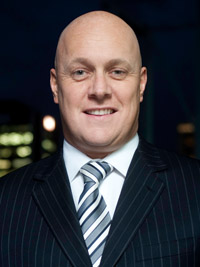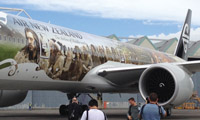Executive Interview
OPEN TO QUESTION
Air New Zealand’s new chief executive, Christopher Luxon, believes in an open door policy that extends throughout the airline. But he stresses the change in leadership is more about evolution than revolution.
February 1st 2013
In his past life as boss of Unilever’s Canadian division, Christopher Luxon, would spend one week a month on the back of an ice cream truck or filling shelves in a supermarket. Read More »
 |
| 'In my old life, I spent one week out of four on the back of an ice cream truck, or filling shelves in supermarkets, because that’s how you gain the real knowledge' |
| Christopher Luxon Chief Executive Air New Zealand |
“That’s how you gain the real knowledge and a feel for what’s going on in the organization,” said the 42-year-old recently appointed Air New Zealand (Air NZ) chief executive. “I love getting out and about.”
And he has wasted no time in doing just that in his new role. Like his predecessor at the airline, Rob Fyfe, Luxon has been on the shop floor working hand-in-hand with staff.
“It has enabled me to get more familiar with various parts of our business; our holiday stores, or technical operations, the regional airlines. I’ve visited them all. I have been out on the ramp baggage handling,” he said.
“I need to hear it straight. I don’t want to be in a command and control mentality where someone can’t get into my office.”
Luxon may be relatively new to the airline business, but he has had one major advantage over most other CEOs taking over a national flag carrier: a six-month transition period.
The Christchurch-born executive, who took over from Fyfe in January, honed his airline skills running Air NZ’s international arm after he joined the carrier in May 2011 from Unilever.
“The transition has been valuable in the sense that one, it gives me a chance to get out and see more of the business. Secondly, it has given me a chance to see more of the industry and our key partners around the world and, thirdly, it has enabled me to really think about the future and our strategy in the next five years,” said Luxon.
He and his team are starting from a high base. “We are an airline that is successful. The question is: how do we go beyond where we’ve come from? That’s why I’m calling it the ‘Go Beyond Plan’,” said Luxon.
“We can be very proud about the journey we have been on in the last 10 years, but we’re not going to be complacent. We are going to think about how we reframe and take the bar higher in all dimensions of the business.”
Luxon worked alongside Fyfe during the transition, but he also spent time with Fyfe’s predecessor, Ralph Norris, who led the carrier out of near-bankruptcy after the New Zealand government took over the airline a decade ago.
 |
| Air New Zealand advertises itself as the airline of Middle-earth, linking it to the Lord of the Rings movie trilogy and the latest screen blockbuster, The Hobbit, an Unexpected Journey, filmed around the country’s spectacular scenery. |
“I am trying to see all the past CEOs because that’s how you learn and don’t repeat mistakes. Between Ralph, Rob and myself we understand [the industry] is about people. There’s a common thread about the kind of leaders we are,” he said.
Luxon said his challenge was to keep enhancing “the good stuff” Air NZ has built in the past 10 years. “I keep saying to staff that it’s a bit like the All Blacks [rugby team]. They were a winning team 20 years ago and 10 years ago, but they play the game very differently today than 10 years ago.
“We’re an airline that is different from 10 years ago and different to five years ago. We should be different in five years time,” he said.
He is full of praise for his predecessors. Norris was “a key catalyst” for re-setting the business. “Rob then stepped in and did an outstanding job opening up and building the business into a much more customer-centric place.
“That’s really important. If you don’t realize that our business is all about people then that’s a big, big problem. We have 11,000 employees. We have 40,000 passengers every day and you have to understand the interaction of 11,000 employees and 40,000 customers. Each morning we start a new show,” said Luxon.
Luxon believes the big opportunity for Air NZ is its position on the edge of the Pacific Rim. “We are fortunate the world’s moving to the Pacific Rim region. You have more opportunity in the Americas, in Asia and a lot more opportunity in Australia and Australasia. Between those three geographies we can build out a business,” he said.
“New Zealand wants to be more successful economically and our connectivity with the region is improving a lot. That helps promote New Zealand’s advance and Air NZ,” he said.
With New Zealand high on the “to do” list of many world travellers – a position expected to receive a huge boost from the success of the movie, The Hobbitt, an Unexpected Journey – Luxon said Air NZ would put a strong focus on opening up and developing markets.
But what Luxon won’t do is accept that New Zealand’s location “at the end of the world” is a barrier. “I hear that a lot in this industry. People use natural disasters, fuel, economic crises, competition and geography as excuses and I don’t buy that logic,” he said.
“They are uncontrollable for sure. The big question is: can you behave better in the moment of changed circumstances than your competitor? If you have built a culture that is more nimble and innovative, you can respond.
“I can tell you that in my tenure there will be, sadly, more natural disasters, more economic meltdowns and a lot more competition. I suspect fuel prices will stay high and could go higher. What interests me is if I can respond better than the other guy in those uncontrollable moments, partly through culture, partly through risk mitigation.”
Air NZ won’t be pressing ahead on its own. Although a Star Alliance member, the carrier will continue to look for compatible partnerships to help with network and market growth.
Already, it has a strong partnership with non-alliance member, Virgin Australia, in which it holds an equity stake. It recently sealed a code-share deal with oneworld’s Cathay Pacific Airways on the Hong Kong route.
“We are going to have to evolve the (alliance) model and be more flexible. For smaller airlines like us we need access to partners that can help us. At the same time, we can help them. There are theatres of the world where there are not Star players.
“Star is the first port of call, but equally we have to be more flexible and pragmatic. We need partners in parts of the world whether there is a Star partner or not.”
Air NZ will experience fleet changes in the not-too-distant future. “The complexity of our fleet will diminish tremendously and it’s going to start happening pretty soon,” said Luxon.
“Our challenge is to simplify the medium and long-haul international market to two types. I think we will end up with B777s and B787s in widebody aircraft and A320s for short-haul.”
Currently, Air NZ has 37 aircraft for its international routes: two B747-400s, five B777-300ERs, eight B777-200ERs, five B767s and 17 A320s. Ten 320s are on order, as well as 10 B787-9s, which will begin arriving next year.
For domestic regional operations in New Zealand the airline has 11 ATR72-500s, 23 Bombardier Q300s, 18 Beechcraft 1900Ds and seven ATR72-600s on order.